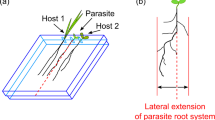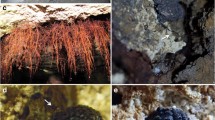Abstract
MEMBERS of the family Orobanchaceae are root parasites attached underground to suitable hosts. In some cases attachment is effected by special mechanisms of the parasite. For example, the mature seed of Orobanche, stimulated chemotropically by diffusion of compounds from the host, germinates and its extending radicle establishes contact with the host1,2. We report here a previously unknown mechanism in Boschniakia hookeri, a perennial parasite found only on the roots of certain members of the Ericaceae in a narrow westerly distribution on the North American continent. We found that the connection of the parasite to the host is due ultimately to the behaviour of the host root, which grows through the testa of the parasite's seed into contact with the embryo.
Similar content being viewed by others
References
Vaucher, J. P. Mém. Mus. Hist. nat. Paris 10, 261–273 (1823).
Kuijt, J. The Biology of Parasitic Flowering Plants (University of California Press, Berkeley and Los Angeles, 1969).
Tiagi, B. Bot. Notiser 116, 81–93 (1963).
Author information
Authors and Affiliations
Rights and permissions
About this article
Cite this article
OLSEN, S., OLSEN, I. Growth of host root establishes contact with parasitic angiosperm Boschniakia hookeri. Nature 279, 635–636 (1979). https://doi.org/10.1038/279635a0
Received:
Accepted:
Issue Date:
DOI: https://doi.org/10.1038/279635a0
- Springer Nature Limited





